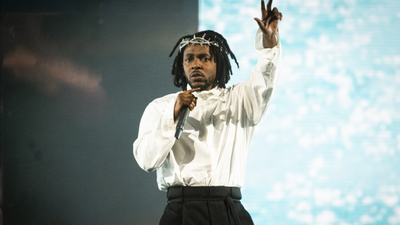Kendrick Lamar's Big Steppers Tour Is More Than Just a Rap Show
The Big Steppers Tour isn’t just a rap show, it’s an expansive experience. Throughout it, Kendrick Lamar's headspace is probed, examined, and pushed to the forefront.
Kendrick Lamar’s return was something that was bound to happen. May was marked by his heavily anticipated album Mr. Morale & The Big Steppers.
On Saturday his second show of The Big Steppers Tour with nearly 19,000 onlookers in the Barclays Center took place. If you found the album moving and breaking through convention, the show was just that too.
The last time I saw Kendrick was ten years ago as a college student in Tallahassee. He was fresh off of releasing his second album good kid, m.A.A.d city. I remember being surrounded by at least a thousand others and being awed at his electric stage presence and how it poured into the crowd. The high expectations I had for the evening in Brooklyn were met mainly due to how natural he appeared to be. The humanness bled through and this too was compelling and powerful, I’ll say it’s an innate power Kendrick has.
The Big Steppers Tour is intricately filled with well-thought-out additions such as the use of shadows, a silver glistening glove clearly inspired by Michael Jackson, dancers who made me think of liturgical dancers in a church, and also stellar lighting. The stage design was brilliant also. Each of these puzzle pieces makes a way for concertgoers like myself to better understand themes that were on Kendrick’s mind while he was creating his latest album: self-reflection and grappling with being a Christ-like figure.
Before he begins it's obvious things won’t be able to be described as a straightforward hip-hop show. One element calls this out immediately: dancers appearing in full suits walking toward the front of the stage one by one. But then Lamar is finally revealed sitting alone playing a piano, his back is to the audience and I ponder if this is how he often feels as an artist. The beginning moments of “United In Grief” rings off and then Kendrick intently starts rapping whilst still sitting, he eventually walks down the stage’s walkway – once there he stands and completes the lyrically heavy song. This moment is followed by a rendition of “N95.” A single white spotlight beams down as he recants this single ferociously, as the song picks up speed fireworks and additional spotlights are added.
Instead of running through songs without stopping, choreographers appeared many times alongside Kendrick. Hellen Mirren’s voice also rang throughout the Barclays Center and this mainly segued each song off of Mr. Morale. Mirren didn’t just serve as a narrator, she also checked on him as if she was Lamar’s therapist.
Choreography paralleled alongside Kendrick’s rapping was something he’d previously done at other tour stops. But, seeing it firsthand made the show appear to be art-centric and not just dreamed up for rap fans.
The most eccentric and thought-provoking moments of the entire show were when Kendrick would hop from one song of Mr. Morale to the strongest songs of his past. “Worldwide Steppers” into “Backseat Freestyle” was unexpected. And so was “Rich Spirit” (a solid choice) which then immediately poured into “Humble.” It was a bit ballsy to mesh tracks out of order, we wonder if this was the rapper’s intention. Was he hoping to leave his fans with a feeling of introspection by the time they head home?
Experiencing the crowd frantically rapping along with Kendrick to “Element,” “m.A.A.d. city,” “King Kunta,” “Bitch Don’t Kill My Vibe (Remix),” “DNA,” and “Money Trees” felt electric. These older songs were selected for a reason, I assume to grapple with his influence. Each song has distinct significance to where Lamar was in his career when he released his albums good kid, m.A.A.d city, DAMN, and To Pimp A Butterfly.
Is Mr. Morale & The Big Steppers a messy album? Yes. And even though the 90-minute set allows space for the album to be covered almost in its entirety (sans the problematic “Auntie Diaries” and “Mother I Sober.”) Yet, there’s something in the air during Kendrick’s performance that proves he’s still grappling with stretching himself musically while he deals with the toxic habits, fatherhood, a savior complex, and people’s expectations. When he’s literally put into a box to be tested for COVID-19 with four men in hazmat suits this is a definitive moment of the set. It's then that we are able to visualize what the album is possibly getting at: being a rapper at this stage of his career is about subverting being put into a box, powerful. But, someone else at the show might have taken this moment differently.
When he’s nearly done with his set he brings out Baby Keem for “Family Ties,” though the rapper had previously come out and held his own this shared moment is moving. Then, before 11 p.m. hits Lamar returns to the piano where he is back in solitary mode. Before he exits, he dives into “Crown,” “Mr. Morale,” and “Savior.” It’s an interesting close to the show. It’s definitely not a safe closing, instead, it's risky as these songs are low tempo. This closing is reflective too, but so was Mr. Morale & The Big Steppers in its entirety.
The Big Steppers Tour isn’t just a rap show, it’s an expansive experience. Kendrick’s headspace is probed, examined, and pushed to the forefront – alongside this ideal, fans are tasked with thinking for themselves rather than relying on Lamar to make up their minds for them. Reckoning with what you’ve pulled from his latest album should lead you to understand why Lamar is a pioneering hip-hop figure.
